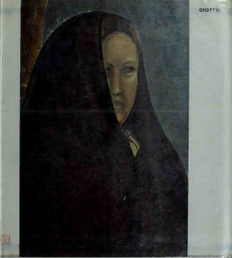Table Of ContentGIOTTO
*'»
M
RA
THE TASTE OF OUR TIME
GREAT BOOKS IN A SMALL FORMAT
MONOGRAPHS
FRA ANGELICO - EL GRECO - GIOTTO
GOYA - PIERO DELLA FRANCESCA
BOTTICELLI - CARPACCIO - BRUEGEL
VELAZQUEZ - REMBRANDT - MANET
CEZANNE - RENOIR - CLAUDE MONET
DEGAS - GAUGUIN - LAUTREC - DUFY
ROUAULT - VAN GOGH - MODIGLIANI
MATISSE - PICASSO - CHAGALL - KLEE
Forthcoming
BOSCH - BRAQUE
THE GREAT \R REVOLUTIONS
I
IMPRESSIONISM (2 VOLUMES)
CUBISM - FAUVISM
Forthcoming
DELACROIX AND ROMANTICISM
COURBET AND REALISM
FAMOUS PLACES
AS SEEN BY GREAT PAINTERS
MONTMARTRE
VENICE
PARIS IN THE PAST
PARIS IN OUR TIME
Colorplates on the jacket:
The Meeting at the Golden Gate (detail),
Scrovegni Chapel, Padua.
The Entry of Christ into Jerusalem (detail),
Scrovegni Chapel, Padua.
I
Distributed by
THE WORLD PUBLISHINGCOMPANY
2231 WEST IIOTHSTREET
CLEVELAND 2,OHIO
7'
THE TASTE OF OUR TIME
Collectionplanned and directed by
ALBERT SKIRA
BIOGRAPHICAL AND CRITICAL STUDY
BY
EUGENIO BATTISTI
Translatedfrom the Italian byJames Emmons
GIOTTO
RA
Title page:
ScenesfromtheLifeofJoachim:TheAnnunciationtoStAnne
(detail), 1305-1306. Fresco. Scrovegni Chapel, Padua.
© by Editions d'Art Albert Skira, i960.
Library ofCongress Catalog Card Number: 60-8730.
Distributed in the United States by
THE WORLD PUBLISHING COMPANY
2231 West 110th Street - Cleveland 2, Ohio
Giotto studies have reached a decisive turning point. A
careful sifting of the available documents is now making
it possible to establish a more satisfactory chronology of the
artist's ceuvre. Recent restorations of the Santa Croce frescos
in Florence have yielded almost miraculous results. Cleared of
19th-century repainting, the frescos in the Bardi Chapel have
revealed an unexpected freedom of handling and coloristic
verve those in the Peruzzi Chapel have confirmed the unprece-
;
dented monumentality so much admired in the High Renais-
sance. Many panel paintings too, by Giotto or his school, have
been restored to something very like their original state. In the
same way, with the work of cleaning now in progress, visitors
to the Scrovegni Chapel in Paduawill soon be able to appreciate
unsuspected refinements ofcolor in the frescos there.
We find ourselves, then, nearly seven hundred years after
Giotto's birth, in the presence of a group of really admirable
works, easily accessible, which modern techniques of repro-
ductionenableus to compareintheirminutestdetails, andwhich
everytourist to Italymakes apoint ofseeing. Neverhas Giotto's
fame been so great as it is now. Innumerable studies and mono-
graphs have been devoted to him, while technical analyses ofhis
great fresco cycles have reached the stage where we can almost
follow their development day by day, can almost fathom the
master mind behind them, and even grasp the mainsprings of
his craftsmanship as well as his artistry, the human side of the
man as well as his genius.
Yet, for all this, Giotto remains profoundly enigmatic.
Equally enigmatic remain the origins of monumental painting
in Tuscany. The problems so far solved have given rise to a
thousand others, which call for solution in turn. In the light of
the authentic documents, not only the older interpretations
of Giotto but even the most recent seem biased or out of date.
Our analytical method also contains an element of uncer-
tainty. If we confine our study to autograph works, in which
the artist's hand seems to haveleftits mark, thenGiotto's world,
alreadygrievouslydiminishedbysomanylosses, appearsnarrow
indeed in view of the fame it enjoys and the impact it has had.
If on the other hand we enlarge the field of scrutiny, we do so
at the risk oflosing any valid criterion ofjudgment. His pupils
and imitators, the Trecento critics and his Renaissance admirers,
all contributed to create what might be called the Giotto myth.
And the historical importance of this myth is in a sense greater
than that of Giotto himself. Like Cubism in our time, Giottism
grew into a movement transcending any single personality,
evolving in accordance with laws of its own.
This is true, however, not only of the greatest of Trecento
painters, but ofmany masters ofItalian art. One ofthe foremost
architects, thinkers and men oftaste ofRenaissance times, Leon
Battista Alberti, who in some ways resembled Giotto, remains
something of a riddle as far as his own individuality goes, in
spite of the thorough knowledge we have of his masterpieces.
This is largely due to the fact that these great personalities left
the execution of much of their work to pupils and assistants,
or better, created, in addition to their own personal style, a
collective style; they became the moving spirit of a whole
society, and besides being artists were men ofaction. So that to
confine ourselves to their autograph works amounts, in effect,
to removing them bodily from a much larger historical and
cultural context. But on the other hand, if we fail to go back

